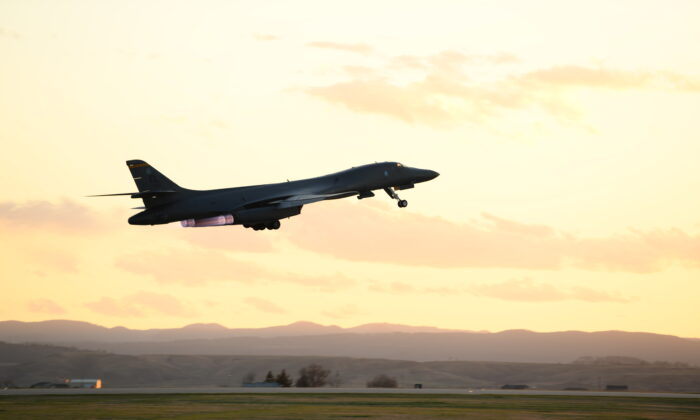
A B-1B Lancer assigned to the 28th Bomb Wing launches from Ellsworth Air Force Base in South Dakota on April 28, 2020. (U.S. Air Force photo by Senior Airman Nicolas Erwin)
Long-Distance Relationships: Bombers Shift Strategy to Counter Russia, China
Last week, two B-1 Lancers—the heavy-lifters of the U.S. bomber family—headed to the Black Sea from South Dakota on a nonstop 14,000-mile, 29-hour round trip.
It was the sixth long-range mission from the mainland United States in just six weeks, all aiming to showcase the Department of Defense’s new strategy: dynamic force employment.
“Bombers will instead be employed in a far more dynamic fashion, or they’ll be surged from home stations, predominantly, if not exclusively in the continental United States, and conduct missions around the world,” Timothy Walton, a defense analyst at the Hudson Institute, told The Epoch Times.
“This shift initially drew some concern because continuous bomber presence has been viewed by U.S. citizens in the Marianas, and then U.S. allies in the region as a clear signal of U.S. resolve in the region.”
However, the vigorous adoption of the new approach over the last few weeks has alleviated some of the concerns allies have, Walton says.
“In fact, it’s likely that bombers operating from U.S. bases are now even more capable than they were in the past.”
The Guam Killer Missiles
While the flight times are longer, in general, the bombers—which are old and battle-weary from the war on terror—will be better maintained and have greater access to munitions stores on the mainland, he says.
In April, for the first time in 16 years, the U.S. Air Force left the key strategic Pacific island of Guam with no heavy bombers. A few days later, a U.S. B-1 flew on a Bomber Task Force Mission to the Pacific on a 30-hour round trip to Japan from North Dakota, with the Air Force saying it was showcasing a new “dynamic force employment” strategy.
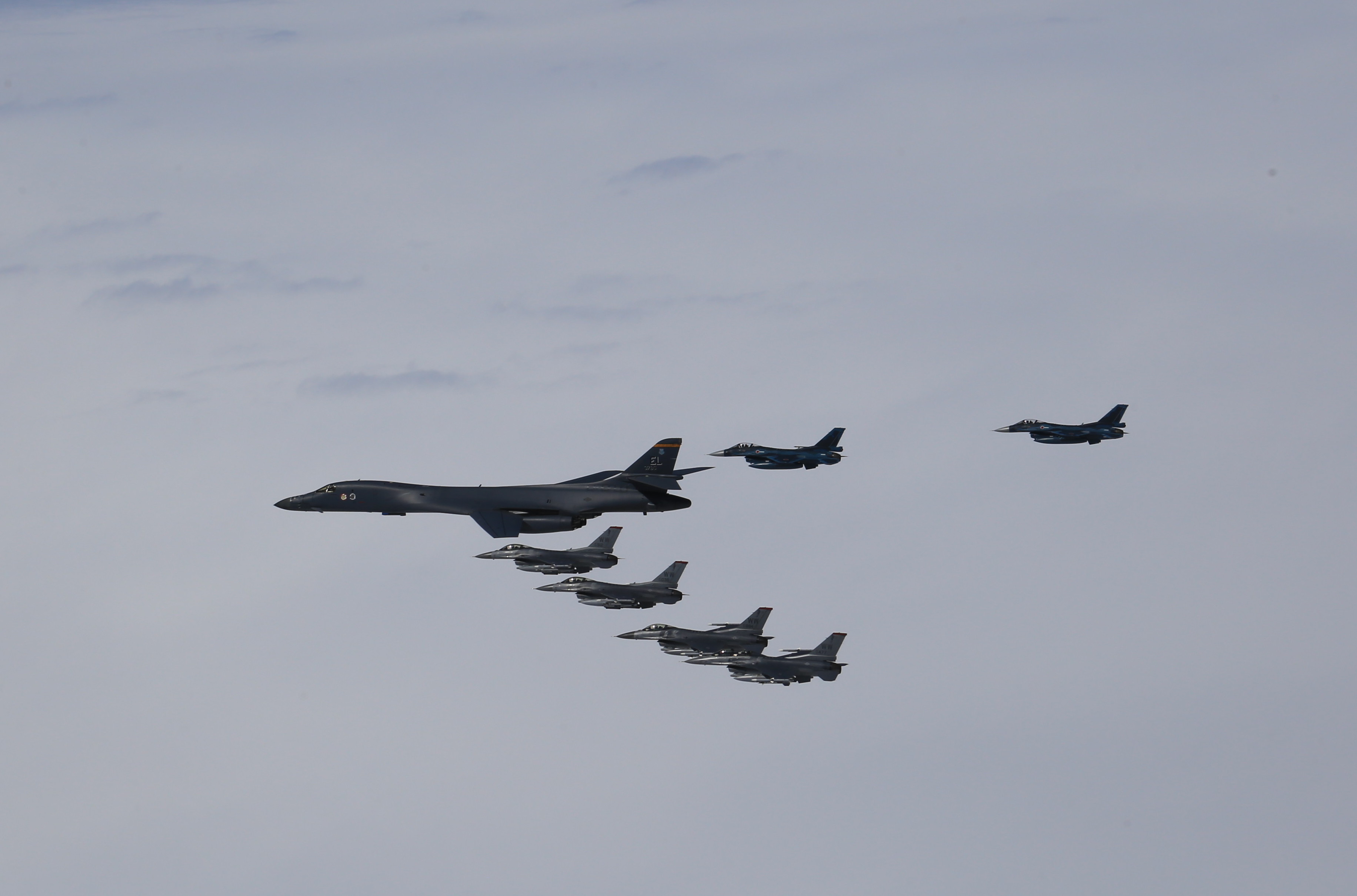
A U.S. Air Force B-1B Lancer from Ellsworth Air Force Base, South Dakota, and F-16 Fighting Falcons from Misawa Air Base, Japan, conducted bilateral joint training with Japan Air Self-Defense Force (JASDF) F-2s and F-15s off the coast of northern Japan on April 22, 2020. (Japan Air-Self Defense Force)
The strategic shift is one of many changes aimed at unpicking the strategic prowess accumulated by China and Russia in recent decades.
Beijing’s war chest swelled around tenfold over the past couple of decades, and China amassed the world’s biggest arsenal of long-range missiles, while the United States was focused on the war on terror.
One of China’s farthest-reaching missiles, the D-26, has even been dubbed the “Guam killer.”
Meanwhile, Russia has also built up its air defenses and long-reaching missiles across its frontier in Europe.
The U.S. military in 2018 began to pivot to face renewed power competition with Russia and China as its top priority, modernizing and rethinking decades-old strategies. The shift was driven by the Trump administration’s National Defense Strategy, which among other changes called for the military to be “strategically predictable, but operationally unpredictable.”
That demand for a more fleet-footed military spawned “dynamic force employment”—which has been an experiment by the Navy and Army. The aim is to avoid the predictability of fixed rotations or of permanent presence, stretching the same forces further, and keeping adversaries off-balance.
In 2018, for the first time in a decade, the Arabian Gulf was left without an aircraft carrier strike group, as the USS Harry Truman, which sailed to the Arctic Circle, became the first carrier to patrol there since the Cold War.

Sailors stand on the flight deck after launching an F/A-18F Super Hornet from the Nimitz-class aircraft carrier USS Harry S. Truman (CVN 75) in the North Atlantic on Sept. 18, 2018. (2nd Class Anthony Flynn/DoD
That was the first taste of dynamic force employment for the Navy, with deployment cycles—sometimes known two years in advance by sailors’ families and Chinese generals alike—now being broken into unpredictable missions.
Enough Skin in the Game?
Mark Gunzinger, a former deputy assistant secretary of defense and a former B-52 pilot, told The Epoch Times that the Air Force is now beginning to shift toward the strategy—but suggests it is, in some ways, not new.
“While dynamic force employment is a term currently in vogue and a good term, and it is very descriptive of what the Joint Force is doing, I would argue that dynamic force employment as a much broader concept is exactly what our Air Force has done for a very, very long time.”
Some analysts have said that the shift away from Guam was as much about getting bombers out of harm’s way from Chinese missiles as about a new strategy.
Gunzinger, now a fellow at the Center for Strategic and Budgetary Assessments, says that’s a fair point.
“I don’t think our Air Force would disagree, or DoD for that matter, that increasingly our bases abroad—certainly along the first island chain and even the second island chain—are increasingly vulnerable to air missile attacks by China. That’s part of China’s overall strategy: to grow its capability and capacity to strike with precision over longer and longer ranges.”
“Airmen know that the best way to kill your enemy’s air forces is to attack them where they tend to be most vulnerable—and that’s on the ground before they can launch. So, airbase attack, seaport attacks, etc, are part of China’s strategy, certainly.”
“Demonstrating that we can fly sorties from the U.S. if necessary, that we can deploy to lots of different places in Europe, in the Indo-Pacific in the Middle East that matter and operate out of there, if necessary, again, creates a much harder challenge for our competitors who have to try to puzzle out how we will deploy.”
But John Venable, a defense analyst at the Heritage Foundation and former Air Force commander, thinks that the deterrence effect is limited.
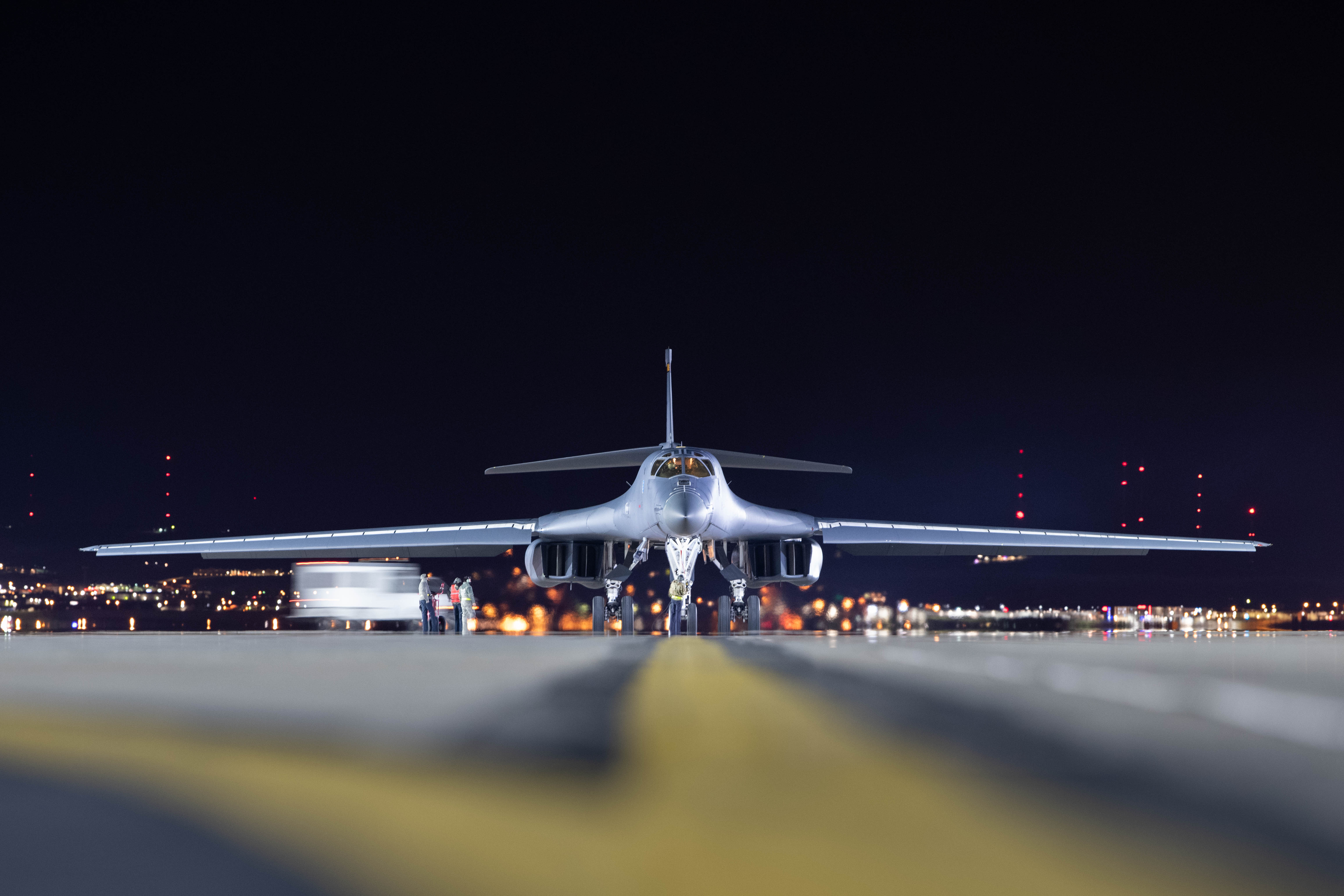
A B-1B Lancer assigned to the 28th Bomb Wing is taxied to parking at Ellsworth Air Force Base in South Dakota on April 30, 2020. (U.S. Air Force photo by Tech. Sgt. Jette Carr
For the likes of the Philippines, Iran, or even North Korea, the current token sorties could act as a deterrent, Venable told The Epoch Times.
“When you see a B-52 off your coastline, that’s a significant message,” he says.
But for Russia and China, those numbers need to be a lot higher for credible deterrence, Venable says.
“This idea that you can provide ‘strategic deterrence’ with one or two platforms, is something that the Chinese or the Russians would just kind of chuckle at.”
He’s saying that sheltering totally out of harm’s way on mainland United States, with no skin in the game, demonstrates a lack of resolve to allies.
Venable flew fighter jets during the Cold War.
“When I was based in Europe, everyone in Germany and in the Netherlands and in England and in Spain where I was based, all of those locations were at risk with Soviet weaponry of one type or another.
“We have to be there to show our intent our resolve to hold the line. Moving those bombers back to the United States from Guam removes that thought process of resolve.”
But the strategy is still just in the testing phase, Walton says.
“I think it demonstrates the Air Force’s commitment to actually shift to this dynamic force employment. And what has started now, with one to two aircraft in flight, may grow in the future.”
“But more importantly, it develops the institutional knowledge for how to conduct those types of operations and synchronize with necessary aerial refueling.”
“When you see a B-52 off your coastline, that’s a significant message,” he says.
But for Russia and China, those numbers need to be a lot higher for credible deterrence, Venable says.
“This idea that you can provide ‘strategic deterrence’ with one or two platforms, is something that the Chinese or the Russians would just kind of chuckle at.”
He’s saying that sheltering totally out of harm’s way on mainland United States, with no skin in the game, demonstrates a lack of resolve to allies.
Venable flew fighter jets during the Cold War.
“When I was based in Europe, everyone in Germany and in the Netherlands and in England and in Spain where I was based, all of those locations were at risk with Soviet weaponry of one type or another.
“We have to be there to show our intent our resolve to hold the line. Moving those bombers back to the United States from Guam removes that thought process of resolve.”
But the strategy is still just in the testing phase, Walton says.
“I think it demonstrates the Air Force’s commitment to actually shift to this dynamic force employment. And what has started now, with one to two aircraft in flight, may grow in the future.”
“But more importantly, it develops the institutional knowledge for how to conduct those types of operations and synchronize with necessary aerial refueling.”
The Role of the Bombers
The role of bombers in a full-blown conflict is to deliver a large quantity of ordnance on high-value targets—including those that may be deep in an adversary’s territory.
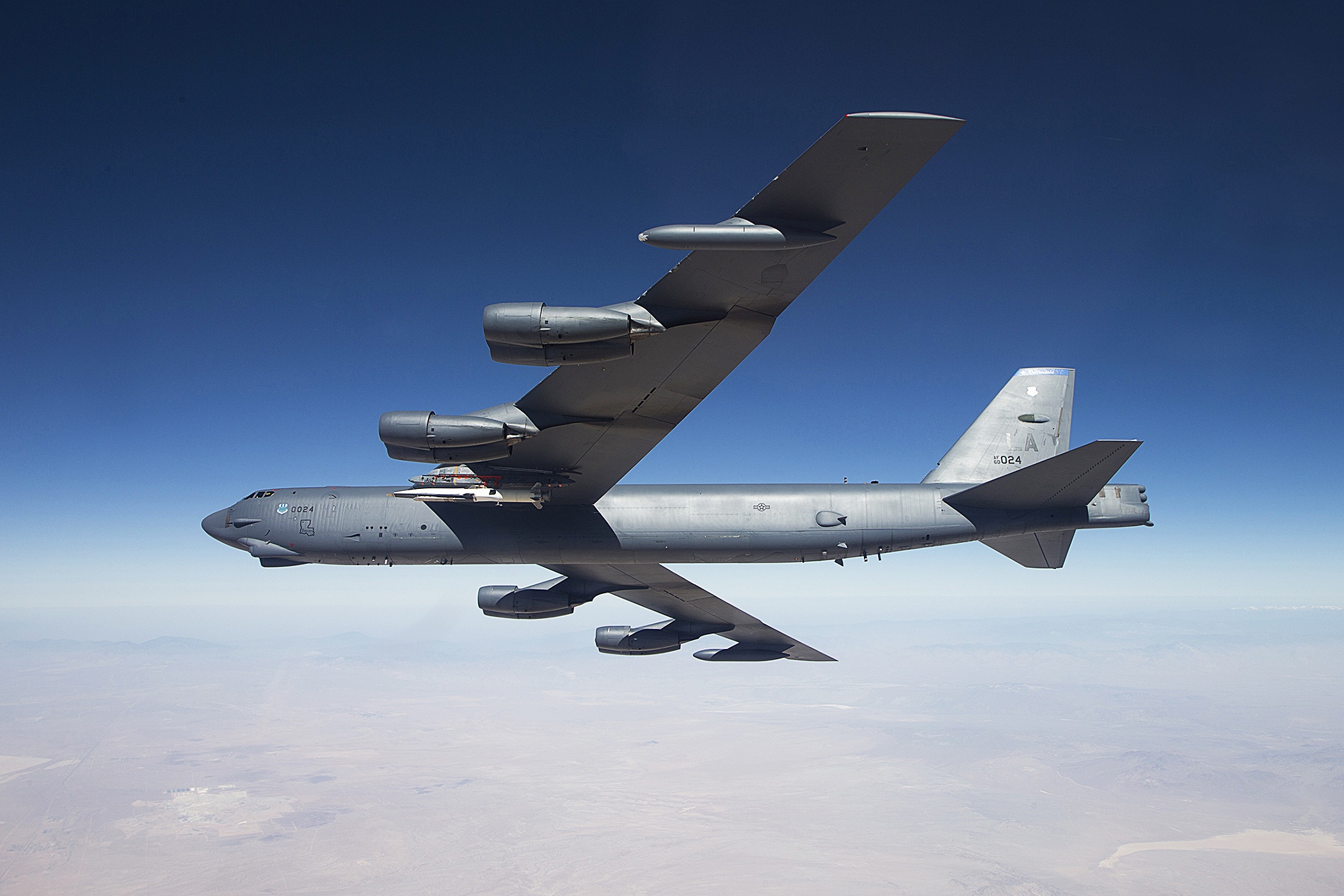
The X-51A WaveRider, attached to the inner wing of a B-52 Spirit, flew its fourth and final mission on May 1, 2013, over the Point Mugu Naval Air Warfare Center Sea Range in California. (U.S. Air Force photo/Bobbi Zapka)
Both Russia and China have the advantage of vast umbrellas of protection against aircraft and missiles in the Pacific and Baltic—known as Anti-Access Area Denial (A2Ad) in military circles.
Bombers provide the ability to take the fight to high-value military targets directly from the U.S. homeland, Gunzinger said.
“Frankly, the only capabilities that we have that can attack on night one, go on the offensive and take the fight deep into enemy’s territory is our bomber forces and, more specifically, our penetrating bomber forces,” he said.
Venable agrees.
“Bombers will play an enormous role in a conflict with China,” says Venable. ” They will have to.”
“The standoff munitions that are on the B-52s and the B-1s are really excellent munitions, and they’re getting better over time. The B-2 is more freefall-based, but it has the ability to penetrate the airspace, go in and strike targets, because of its stealth coating.”
A new stealth bomber, which will be able to slip inside territories, is in the pipeline.
The B-21 will bring next-generation technology, but many of the features are currently classified.
One of the less glamorous advantages will be its tougher skin, Venable says.
“The stealth coating on the B-21 is going to be much higher than it is for the B-2. When the B-2 flies through a rainstorm or hits a lot of bugs—and I don’t mean to make fun of this idea—or anytime something impacts the skin of that airplane, they have to go in and repair it so that it sustains its stealth faculties.”
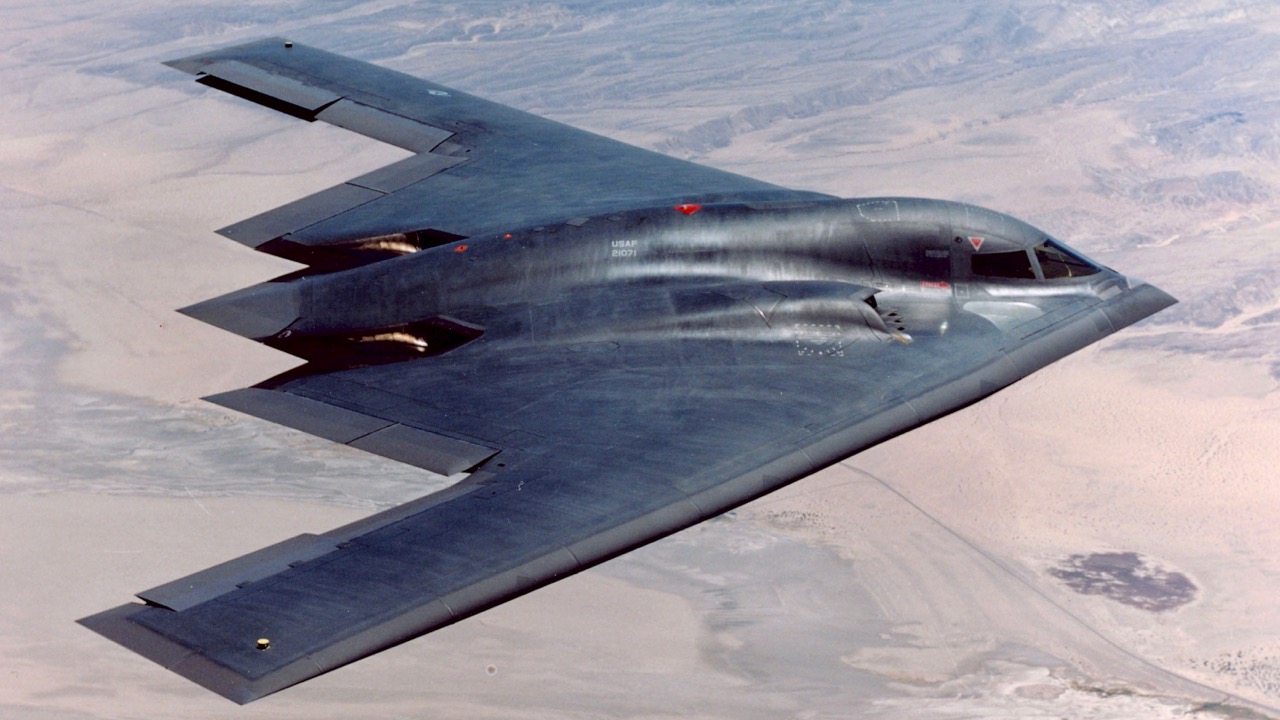
B-2 flies over Edwards Air Force Base in California on Aug. 14, 2003. (U.S. Air Force/Getty Images
Currently, the Air Force is slated to pick up 100 B-21s when they finally start rolling off the production line—expected sometime before the end of the decade.
Stretched Thin
But for many, the B-21 can’t come soon enough. Generally, defense analysts agree that the U.S. current bomber fleet—like the air force in general—is old, tired, and too small.
Dynamic force employment helps that fleet go a little further.
“The U.S. bomber force is small. It’s historically small right now,” says Walton.
The B-1 fleet is also worn out.
Walton says, “The aircraft type was used extensively in operations in Afghanistan and throughout the broader Middle East over the past decade, operating in the manner in which you would loiter over the battlefield and deliver large numbers of munitions.”
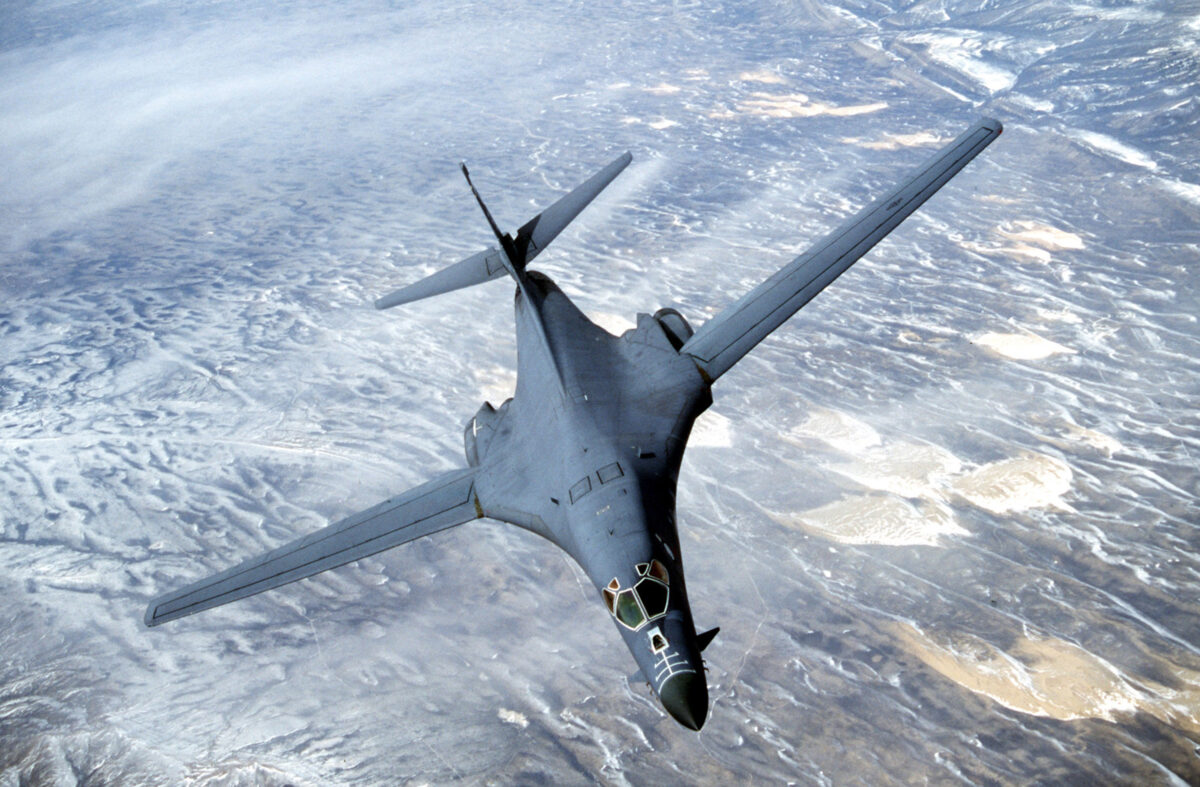
A B-1B Lancer from the U.S. Air Force 28th Air Expeditionary Wing heads out on a combat mission in support of strikes on Afghanistan in a file photo. (USAF/Getty Images)
It was very successful in that role, and B-1s were equipped with a targeting pod to enable them to effectively play the role of close support aircraft. But the reality is it has taken a toll on the aircraft airframe, and the overall readiness of that fleet has declined.”
The Air Force is now considering cannibalizing parts from those aircraft to maximize the readiness of the other bombers, says Walton. “Whether Congress will agree with that plan remains to be seen.”
The Air Force is now considering cannibalizing parts from those aircraft to maximize the readiness of the other bombers, says Walton. “Whether Congress will agree with that plan remains to be seen.”
Numbers Count
Gunzinger also says that basing the bombers on the mainland has benefits.
“Guam just kind of lacks the infrastructure needed to make maintain some of our crews fully mission capable,” he says. “So there was some decrease in their readiness by maintaining their long term presence in Guam.”
Venable agrees that the new strategy helps the aging fleet by preserving the airframes and saves on deployment time, and ops tempo.
But Venable is worried the math doesn’t look too good—especially when the concept of mission-capable rates is applied.
“Our actual total numbers of operational bombers come out to roughly 115,” he says. “When you apply mission capable rates to that those numbers you only have approximately 70 total bombers available on any given day that can go out and execute the mission.”
With a 30 hour round-trip from the United States to China, Venable says that means a lower number of sorties.
In theory, the arrival of the B-21 will refill the ramps and improve the numbers, says Venable.
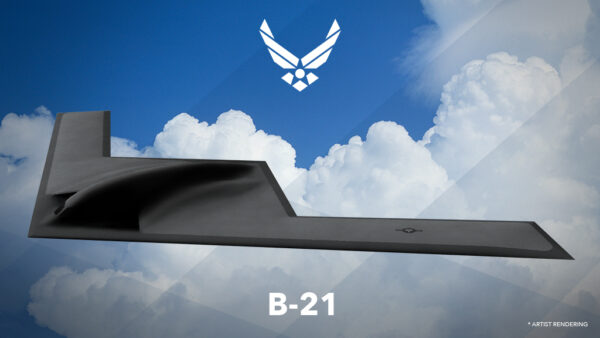
An artistic rendering of the B-21 Raider design. (U.S. Air Force/Northrop Grumman)
But he worries that history may repeat itself, noting that originally, the Air Force expected B-2 bombers. Just 20 were made.
In addition to the B-21, the Air Force is also working on next-generation weapons to mount on their bombers.
“We really do need fifth-generation weapons to go with our next-generation platforms,” says Gunzinger. “Because China’s in Russia’s air, integrated air defense systems are increasingly effective against individual weapons, as well as aircraft themselves.”
US Air Force | SAC Command Post (Strategic Air Command)
https://youtu.be/Jj_VdjAzZRI?t=76
https://youtu.be/U0Ngjoy9-Jc?t=132
https://youtu.be/Eq43-RpAynk?t=19
U.S. and Russia Start New Nuclear Arms Control Talks Without China
https://youtu.be/U0Ngjoy9-Jc?t=132
https://youtu.be/Eq43-RpAynk?t=19
U.S. and Russia Start New Nuclear Arms Control Talks Without China


One of the penalties for refusing to participate in politics is that you end up being governed by your inferiors. -- Plato (429-347 BC)
THE PATRIOT
"FIGHTING FOR FREEDOM AND LIBERTY"
and is protected speech pursuant to the "unalienable rights" of all men, and the First (and Second) Amendment to the Constitution of the United States of America, In God we trust
Stand Up To Government Corruption and Hypocrisy
Knowledge Is Power And Information is Liberating: The FRIENDS OF LIBERTY BLOG GROUPS are non-profit blogs dedicated to bringing as much truth as possible to the readers.
Knowledge Is Power And Information is Liberating: The FRIENDS OF LIBERTY BLOG GROUPS are non-profit blogs dedicated to bringing as much truth as possible to the readers.
NEVER FORGET THE SACRIFICES
BY OUR VETERANS
Note: We at The Patriot cannot make any warranties about the completeness, reliability, and accuracy of this information.
The Patriot is a non-partisan, non-profit organization with the mission to Educate, protect and defend individual freedoms and individual rights.
Support the Trump Presidency and help us fight Liberal Media Bias. Please LIKE and SHARE this story on Facebook or Twitter.
COMPLAINTS ABOUT OUR GOVERNMENT REGISTERED HERE WHERE THE BUCK STOPS!
GUEST POSTING: WOULD YOU LIKE TO BE PUBLISHED ... DO YOU HAVE SOMETHING ON YOUR MIND?
Knowledge Is Power - Information Is Liberating: The Patriot Welcome is a non-profit blog dedicated to bringing as much truth as possible to the readers.
Big Tech has greatly reduced the distribution of our stories in our readers' newsfeeds and is instead promoting mainstream media sources. When you share with your friends, however, you greatly help distribute our content. Please take a moment and consider sharing this article with your friends and family. Thank you
Please share… Like many other fact-oriented bloggers, we've been exiled from Facebook as well as other "mainstream" social sites.
We will continue to search for alternative sites, some of which have already been compromised, in order to deliver our message and urge all of those who want facts, not spin and/or censorship, to do so as well.
Keep on seeking the truth, rally your friends and family and expose as much corruption as you can… every little bit helps add pressure on the powers that are no more.
Keep on seeking the truth, rally your friends and family and expose as much corruption as you can… every little bit helps add pressure on the powers that are no more.
Those Who Don't Know The True Value Of Loyalty Can Never Appreciate The Cost Of Betrayal.

No comments:
Post a Comment